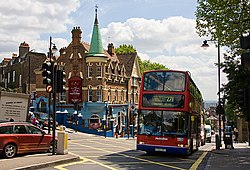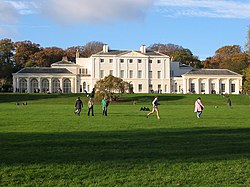Highgate
| Highgate | |
| Middlesex | |
|---|---|
 Highgate Hill | |
| Location | |
| Grid reference: | TQ285875 |
| Location: | 51°34’18"N, 0°8’41"W |
| Data | |
| Post town: | London |
| Postcode: | N6 |
| Dialling code: | 020 |
| Local Government | |
| Council: | Camden, Haringey, Islington |
| Parliamentary constituency: |
Holborn and St Pancras |
Highgate is a suburban area of Middlesex deep within the metropolitan conurbation at the north-eastern corner of Hampstead Heath, 4 miles from the heart of London. It is often spoken of in the same breath as its near neighbour, the similarly upmarket London village of Hampstead - the local paper for both is the "Ham & High". The two are however quite distinct, separated by the broad green upland of Hampstead Heath and Parliament Hill.
This is one of the most expensive London suburbs in which to live.[1] It has an active conservation body, the Highgate Society, to protect its village character.
Until late Victorian times, Highgate was a distinct village outside London, sitting astride the main road to the north. The area retains many green expanses including the eastern part of Hampstead Heath, three ancient woods,[2] Waterlow Park and the eastern-facing slopes known as Highgate bowl.
At its centre is Highgate village, a collection of largely Georgian shops, pubs, restaurants and residential streets,[3] interspersed with diverse landmarks such as St Michael's Church and steeple, St. Joseph's Church and its green copper dome, Highgate School (1565), Jacksons Lane arts centre housed in a Grade II listed former church, the Gatehouse Inn dating from 1670[4] and Berthold Lubetkin's 1930s Highpoint buildings. Highgate is also famous for its atmospheric Victorian Highgate Cemetery, in which several prominent and notorious figures are buried, amongst them Michael Faraday, Douglas Adams, George Eliot, Christina Rossetti, and Karl Marx.
The village is at the top of a hill which provides views across London: it is 446 feet above sea level at its highest point.
History

Historically, Highgate adjoined the Bishop of London's hunting estate. The bishop kept a toll-house where one of the main northward roads out of London entered his land. A number of pubs sprang up along the route, one of which, the Gatehouse, commemorates the toll-house.
In later centuries Highgate was associated with the highwayman Dick Turpin.
Hampstead Lane and Highgate Hill contain the red brick Victorian buildings of Highgate School and its adjacent Chapel of St Michael. The school has played a paramount role in the life of the village and has existed on its site since its founding was permitted by letters patent from Queen Elizabeth I in 1565.
The area north of the High Street and Hampstead Lane was part of Hornsey parish and also later the Municipal Borough of Hornsey and the seat of that borough's governing body for many years.
Highgate Hill, the steep street linking Archway and Highgate village, was the route of the first cable car to be built in Europe. It operated between 1884 and 1909.
Like much of London, Highgate suffered damage during the Second World War from German bombs.. The Highgate tube station was used as a bomb shelter.
Nearest tube stations
- Highgate tube station
- Archway tube station



Places of interest
Highgate is known for its pubs which line the old high street and surrounding streets. Some notable favourites are the Angel, the Flask, the Duke's Head and the Wrestlers.
- Highgate Cemetery
- Highgate School
- Highgate Wood
- Jacksons Lane
- Kenwood House
- Highpoint I and II
- Athlone House formally known as Caen Wood Towers - (Home of the RAF Intelligence School 1942-48)
- Archway Bridge
- Furnival House
- St Michael's Church
In popular culture
- Gothic horror: Highgate's historic feel - in particular the gothic atmosphere of its cemetery - has provided the backdrop to a considerable number of films, including: [5]
- Hammer Horror films of the 1970s
- Shaun of the Dead
- Dorian Gray (2009)
- Dick Whittington and His Cat, the old story as adapted to the stage in 1605 and to pantomime in the 19th century, has a famous scene set in Highgate. The story is loosely based on the historical Richard Whittington, a mediæval Mayor of London. Dick, a boy from a poor family in Gloucestershire, walks to London to make his fortune, accompanied by his cat. He meets with little success there. As Dick and cat are making for home, discouraged, by way of Highgate Hill, they hear the Bow Bells from distant London; Dick believes they are sending him a message to "turn again" - and that he will become Lord Mayor of London. They return; Dick makes his fortune and indeed becomes Lord Mayor. The Whittington Hospital on Highgate Hill is named after the story, and a statue of Dick's faithful pet stands nearby.
- "London Song" by Ray Davies: "If you're ever up on Highgate Hill on a clear day, You can see right down to Leicester Square". The cover shoot for the 1971 Kinks album Muswell Hillbillies took place in various locations around Highgate. The back inset on the original album cover showed the band on the traffic island that used to stand on the intersection of Southwood Lane and Castle Yard. The cover for their 1968 album Village Green Preservation Society was photographed on Parliament Hill, with Highgate as the backdrop.
- The pub tradition of Swearing on the Horns originated in Highgate.
- In Dickens' novel David Copperfield James Steerforth lives in a house at the top of Highgate West Hill.
- Un lieu incertain, a book by French novelist Fred Vargas, picks up the urban legend of the "Highgate Vampire".